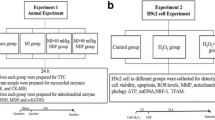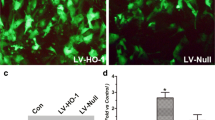Abstract
Oxidative stress is one of the main causes of myocardial injury, which is associated with cardiomyocyte death. Mitochondria play a key role in triggering the necrosis and apoptosis pathway of cardiomyocytes under oxidative stress. Although prohibitin (PHB) has been acknowledged as a mitochondrial chaperone, its functions in cardiomyocytes are poorly characterized. The present research was designed to investigate the cardioprotective role of PHB in mitochondria. Oxidative stress can increase the PHB content in mitochondria in a time-dependent manner. Overexpression of PHB in cultured cardiomyocytes by transfection of recombinant adenovirus vector containing PHB sense cDNA resulted in an increase of PHB in mitochondria. Compared with the non-transfection cardiomyocytes, PHB overexpression could protect the mitochondria from oxidative stress-induced injury. The mitochondria-mediated apoptosis pathway was consistently suppressed in PHB-overexpressed cardiomyocytes after hydrogen peroxide (H2O2) treatment, including a reduced change in mitochondrial membrane permeability transition and an inhibited release of cytochrome c from mitochondria to cytoplasma. As a result, the oxidative stress-induced cardiomyocyte apoptosis was suppressed. These data indicated that PHB protected the cardiomyocytes from oxidative stress-induced damage, and that increasing PHB content in mitochondria constituted a new therapeutic target for myocardium injury.





Similar content being viewed by others
Abbreviations
- PHB:
-
prohibitin
- MEM:
-
modified Eagle’s medium
- Cox II:
-
cytochrome c oxidase subunit II
- LDH:
-
lactate dehydrogenase
- CK:
-
creatine kinase
- MMP:
-
mitochondrial transmembrane potential
- MPTP:
-
membrane permeability transition pore
- H2O2 :
-
hydrogen peroxide
- PBS:
-
phosphate-buffered saline
References
Artal-Sanz M, Tsang WY, Willems EM, Grivell LA, Lemire BD, vander Spek H, Nijtmans LG, Sanz MA (2003) The mitochondrial prohibitin complex is essential for embryonic viability and germline function in Caenorhabditis elegans. J Biol Chem 278:32091–32099. doi:10.1074/jbc.M304877200
Berger KH, Yaffe MP (1998) Prohibitin family members interact genetically with mitochondrial inheritance components in Saccharomyces cerevisiae. Mol Cell Biolm 18:4043–4052
Chowdhury I, Xu W, Stiles JK, Zeleznik A, Yao X, Matthews R, Thomas K, Thompson WE (2006) Apoptosis of rat granulosa cells after staurosporine and serum withdrawal is suppressed by adenovirus directed overexpression of prohibitin. Endocrinology 148:206–217. doi:10.1210/en.2006-0187
Coates PJ, Jamieson DJ, Smart K, Prescott AR, Hall PA (1997) The prohibitin family of mitochondrial proteins regulate replicative lifespan. Curr Biol 7:607–610. doi:10.1016/S0960-9822(06)00261-2
Esch T, Stefano GB, Fricchione GL, Benson H (2002) Stress-related diseases—a potential role for nitric oxide. Med Sci Monit 8:RA103–RA118
Fellenberg J, Dechant MJ, Ewerbeck V, Mau H (2003) Identification of drug-regulated genes in osteosarcoma cells. Int J Cancer 105:636–643
Ferrer I, Perez E, Dalfó E, Barrachina M (2007) Abnormal levels of prohibitin and ATP synthase in the substantia nigra and frontal cortex in Parkinson’s disease. Neurosci Lett 415:205–209. doi:10.1016/j.neulet.2007.01.026
Fusaro G, Dasgupta P, Rastogi S, Joshi B, Chellappan S (2003) Prohibitin induces the transcriptional activity of p53 and is exported from the nucleus upon apoptotic signaling. J Biol Chem 278:47853–47861. doi:10.1074/jbc.M305171200
Gamble SC, Odontiadis M, Waxman J, Westbrook JA, Dunn MJ, Wait R, Lam EW, Bevan CL (2004) Androgens target prohibitin to regulate proliferation of prostate cancer cells. Oncogene 23:2996–3004. doi:10.1038/sj.onc.1207444
Gregory-Bass RC, Olatinwo M, Xu W et al (2008) Prohibitin silencing reverses stabilization of mitochondrial integrity and chemoresistance in ovarian cancer cells by increasing their sensitivity to apoptosis. Int J Cancer 122:1923–1930. doi:10.1002/ijc.23351
He B, Feng Q, Mukherjee A, Lonard DM, DeMayo FJ, Katzenellenbogen BS, Lydon JP, O’Malley BW (2008) A repressive role for prohibitin in estrogen signaling. Mol Endocrinol 22:344–360. doi:10.1210/me.2007-0400
Ikonen E, Fiedler K, Parton RG, Simons K (1995) Prohibitin, an antiproliferative protein, is localized to mitochondria. FEBS Lett 358:273–277. doi:10.1016/0014-5793(94)01444-6
Irving RJ, White J, Chan R (1998) The influence of restraint on blood pressure in the rat. J Pharmacol Toxicol Methods 38:157–162. doi:10.1016/S1056-8719(97)00081-6
Kasashima K, Sumitani M, Satoh M, Endo H (2008) Human prohibitin 1 maintains the organization and stability of the mitochondrial nucleoids. Exp Cell Res 314:988–996. doi:10.1016/j.yexcr.2008.01.005
Kluck RM, Bossy-Wetzel E, Green DR, Newmeyer DD (1997) The release of cytochrome c from mitochondria: a primary site for Bal-2 regulation of apoptosis. Science 275:1132–1136. doi:10.1126/science.275.5303.1132
Knardahl S, Hendley ED (1990) Association between cardiovascular reactivity to stress and hypertension or behavior. Am J Physiol 259:H248–H257
Liu XH, Qian LJ, Gong JB, Shen J, Zhang XM, Qian XH (2004) Proteomic analysis of mitochondrial proteins in cardiomyocytes from chronic stressed rat. Proteomics 4:3167–3176. doi:10.1002/pmic.200300845
McDougall SJ, Paull JRA, Widdop RE, Lawrence AJ (2000) Restraint stress: differential cardiovascular responses in Wistar–Kyoto and spontaneously hypertensive rats. Hypertension 35:126–129
Merkwirth C, Dargazanli S, Tatsuta T et al (2008) Prohibitins control cell proliferation and apoptosis by regulating OPA1-dependent cristae morphogenesis in mitochondria. Genes Dev 22:476–88. doi:10.1101/gad.460708
Montano MM, Ekena K, Delage-Mourroux R, Chang W, Martini P, Katzenellenbogen BS (1999) Proc Natl Acad Sci U S A 96:6947–6952. doi:10.1073/pnas.96.12.6947
Nicoletti I, Migliorati G, Pagliacci MC, Grignani F, Riccardi C (1991) A rapid and simple method for measuring thymocyte apoptosis by a propidium iodide staining and flow cytometry. J Immunol Methods 139:271–279. doi:10.1016/0022-1759(91)90198-O
Nijtmans LG, de Jong L, Artal Sanz M, Coates PJ, Berden JA, Back JW, Muijsers AO, vander Spek H, Grivell LA (2000) Prohibitins act as a membrane-bound chaperone for the stabilization of mitochondrial proteins. EMBO J 19:2444–2451. doi:10.1093/emboj/19.11.2444
Nijtmans LG, Artal Sanz M, Grivell LA, Coates PJ (2002) The mitochondrial PHB complex: roles in mitochondrial respiratory complex assembly, aging and degenerative disease. Cell Mol Life Sci 59:143–155. doi:10.1007/s00018-002-8411-0
Nuell MJ, Stewart DA, Walker L et al (1991) Prohibitin, an evolutionarily conserved intracellular protein that blocks DNA synthesis in normal fibroblasts and HeLa cells. Mol Cell Biol 11:1372–1381
Osman C, Wilmes C, Tatsuta T, Langer T (2007) Prohibitins interact genetically with Atp23, a novel processing peptidase and chaperone for the F1Fo-ATP synthase. Mol Biol Cell 18:627–635. doi:10.1091/mbc.E06-09-0839
Qian LJ, Song XL, Ren HR, Gong JB, Cheng SQ (2004) Mitochondrial mechanism of heat stress-induced injury in rat cardiomyocyte. Cell Stress & Chaperones 9:281–293. doi:10.1379/CSC-20R.1
Rajalingam K, Rudel T (2005) Ras–Raf signaling needs prohibitin. Cell Cycle 4:1503–1505
Schleicher M, Shepherd BR, Suarez Y et al (2008) Prohibitin-1 maintains the angiogenic capacity of endothelial cells by regulating mitochondrial function and senescence. J Cell Biol 180:101–112. doi:10.1083/jcb.200706072
Sharma A, Qadri A (2004) Vi polysaccharide of Salmonella typhi targets the prohibitin family of molecules in intestinal epithelial cells and suppresses early inflammatory responses. Proc Natl Acad Sci USA 101:17492–17497. doi:10.1073/pnas.0407536101
Simpson P, Savion S (1982) Differentiation of rat myocytes in single cell cultures with and without proliferating nonmyocardial cells. Circ Res 50:101–116
Terashima M, Kim KM, Adachi T, Nielsen PJ, Reth M, Kohler G, Lamers MC (1994) The IgM antigen receptor of B lymphocytes is associated with prohibitin and a prohibitin-related protein. EMBO J 13:3782–3792
Thompson WE, Powell JM, Whittaker JA, Sridaran R, Thomas KH (1999) Immunolocalization and expression of prohibitin, a mitochondrial associated protein within the rat ovaries. Anat Rec 256:40–48. doi:10.1002/(SICI)1097-0185(19990901)256:1<40::AID-AR6>3.0.CO;2-X
Thompson WE, Ramalho-Santa J, Sutovsky P (2003) Ubiquitination of prohibitin in mammalian sperm mitochondria: possible roles in the regulation of mitochondrial inheritance and sperm quality control. Biol Reprod 69:254–260. doi:10.1095/biolreprod.102.010975
Vander Heiden MG, Choy JS, VanderWeele DJ et al (2002) Bcl-x (L) complements Saccharomyces cerevisiae genes that facilitate the switch from glycolytic to oxidative metabolism. J Biol Chem 277:44870–44876. doi:10.1074/jbc.M204888200
Vessal M, Mishra S, Moulik S, Murphy LJ (2006) Prohibitin attenuates insulin-stimulated glucose and fatty acid oxidation in adipose tissue by inhibition of pyruvate carboxylase. FEBS J 273:568–576. doi:10.1111/j.1742-4658.2005.05090.x
Wang S, Nath N, Adlam M, Chellappan S (1999a) Prohibitin, a potential tumor suppressor, interacts with RB and regulates E2F function. Oncogene 18:3501–3510. doi:10.1038/sj.onc.1202684
Wang S, Nath N, Fusaro G, Chellappan S (1999b) Rb and prohibitin target distinct regions of E2F1 for repression and respond to different upstream signals. Mol Cell Biol 19:7447–7460
Ward MW, Rego AC, Frenguelli BG, Nicholls DG (2000) Mitochondrial membrane potential and glutamate excitotoxicity in cultured cerebellar granule cells. J Neurosci 20:7208–7219
Acknowledgments
This research was supported by the General Program of the Chinese National Natural Science Foundation (grant no. 30570753) and the Major Research Plan of the Chinese National Natural Science Foundation (grant nos. 30430590 and 30393134).
Author information
Authors and Affiliations
Corresponding author
Additional information
XiaoHua Liu and Zhe Ren contributed equally to this work.
● Prohibitin is an evolutionarily conserved and ubiquitously expressed protein involved in mitochondrial structure, function, and inheritance whose function in cardiomyocyte is not known. In this study, we found oxidative stress could induce increased expression in cardiomyocytes and mitochondrial translocation of PHB, and PHB can protect against oxidative stress in cultured neonatal cardiomyocyte.
Rights and permissions
About this article
Cite this article
Liu, X., Ren, Z., Zhan, R. et al. Prohibitin protects against oxidative stress-induced cell injury in cultured neonatal cardiomyocyte. Cell Stress and Chaperones 14, 311–319 (2009). https://doi.org/10.1007/s12192-008-0086-5
Received:
Revised:
Accepted:
Published:
Issue Date:
DOI: https://doi.org/10.1007/s12192-008-0086-5




